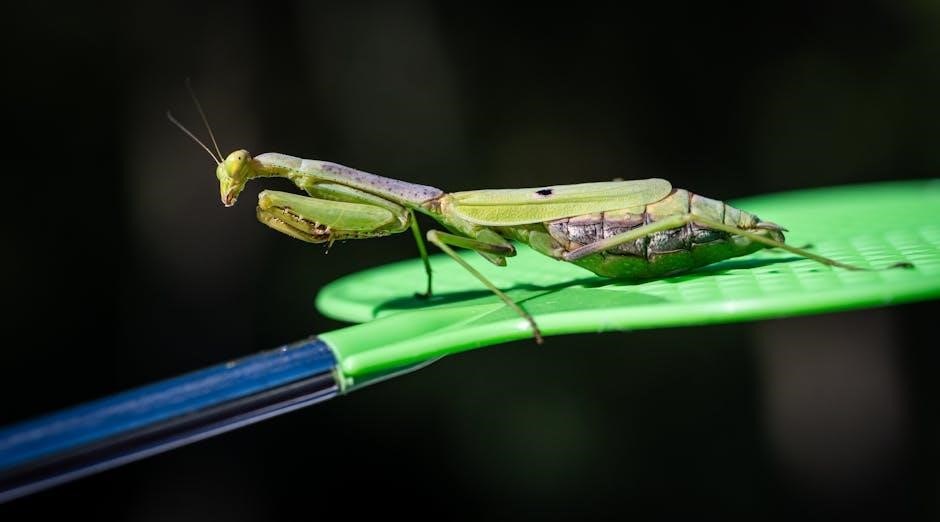mantis tiller owners manual
The Mantis Tiller is a lightweight‚ 20-pound gardening wonder that revolutionizes soil preparation with ease‚ precision‚ and smooth handling‚ transforming the way Americans garden.
1.1 Overview of the Mantis Tiller
The Mantis Tiller is a lightweight‚ 20-pound gardening tool designed for efficient soil preparation and weeding. It combines ease of use with powerful performance‚ making it ideal for gardeners of all levels. Unlike heavier tillers‚ the Mantis Tiller is easy to maneuver and transport‚ allowing for precise control over soil tilling and weed removal. Its compact design and versatility make it suitable for both small and large gardening projects. Whether you’re preparing soil for planting or maintaining your garden‚ the Mantis Tiller is a reliable and user-friendly solution.
1.2 Key Features of the Mantis Tiller
The Mantis Tiller stands out with its lightweight design‚ weighing only 20 pounds‚ making it easy to handle and transport. It features durable tines that effectively cultivate soil and remove weeds with precision. The tiller is powered by a reliable engine‚ ensuring consistent performance. Its compact size allows for easy maneuverability‚ even in tight spaces. Additionally‚ the Mantis Tiller comes with an extensive warranty and dedicated customer support‚ ensuring long-term satisfaction and assistance. These features collectively make the Mantis Tiller a versatile and efficient gardening tool for various soil preparation tasks.
1.3 Benefits of Using the Mantis Tiller
Using the Mantis Tiller offers numerous advantages for gardeners. It simplifies soil preparation‚ saving time and effort by effortlessly breaking up soil and weeds. The tiller’s lightweight design reduces fatigue‚ making it accessible for users of all strength levels. Its compact size allows for precise tilling in small beds and tight spaces. Regular use promotes healthy soil structure‚ enhancing plant growth. Additionally‚ the Mantis Tiller is eco-friendly‚ minimizing the need for chemical herbicides. Its durability ensures long-term reliability‚ making it a cost-effective investment for maintaining a thriving garden. These benefits collectively enhance gardening efficiency and satisfaction.

Safety Guidelines
Always follow safety guidelines to ensure safe operation. Wear protective gear‚ avoid loose clothing‚ and keep children away. Operate in well-ventilated areas and avoid hazards. Adhere to manufacturer instructions for optimal safety.
2.1 General Safety Precautions
Before using the Mantis Tiller‚ ensure the area is clear of debris‚ rocks‚ and obstructions. Always maintain a firm grip and stable stance while operating. Avoid wearing loose clothing or jewelry that could get caught in moving parts. Keep children and pets at a safe distance. Never operate the tiller when fatigued or under the influence of alcohol. Ensure proper ventilation‚ especially in enclosed spaces‚ to avoid inhaling fumes. Familiarize yourself with the tiller’s controls and features before starting. Regularly inspect the machine for damage or wear and address issues promptly to prevent accidents.
2.2 Handling the Tiller Safely
Always maintain a firm‚ two-handed grip on the Mantis Tiller handles to ensure control. Stand with a balanced stance‚ feet shoulder-width apart‚ and keep the tiller close to your body. Avoid overreaching or stretching‚ which could cause loss of balance. When moving the tiller‚ lift with your legs‚ not your back‚ to prevent strain. Be mindful of your body positioning relative to the tiller’s movement. Never leave the tiller unattended while it is in operation. Practice handling the tiller in an open‚ flat area before tilling uneven or obstructed ground.
2.3 Protective Gear Recommendations
Always wear appropriate protective gear when operating the Mantis Tiller to minimize injury risks. Use durable gloves to prevent blisters and improve grip control. Safety glasses or goggles are essential to protect your eyes from flying debris. Wear long pants and closed-toe shoes to safeguard your legs and feet from accidental contact with the tines. Consider using a dust mask to avoid inhaling soil particles. Hearing protection‚ such as earplugs‚ is recommended to reduce exposure to engine noise. Proper attire ensures safer and more comfortable operation of the tiller.

Assembly Instructions
Follow the step-by-step guide to assemble your Mantis Tiller. Carefully unpack and inventory all parts. Use the provided hardware and tools to secure components tightly. Ensure accurate alignment and proper tightening of bolts for safe operation.
3.1 Unpacking and Inventory
Begin by carefully unpacking the Mantis Tiller from its shipping box. Inspect all components for damage; Verify the included items: tiller body‚ handlebars‚ tines‚ hardware kit‚ and instruction manual. Organize the parts on a clean‚ flat surface. Cross-reference each item with the packing list to ensure completeness. If any part is missing or damaged‚ contact customer support immediately. Proper inventory ensures a smooth assembly process. Handle components with care to avoid scratches or bends. Keep all packaging materials until assembly is complete and functional testing is done successfully.
3.2 Hardware and Tools Required
To assemble the Mantis Tiller‚ gather the necessary hardware and tools. Required tools include a wrench‚ screwdriver (both Phillips and flathead)‚ pliers‚ and possibly a socket set. Hardware items provided in the kit include bolts‚ nuts‚ washers‚ and clips. Ensure all parts are organized and within reach. Refer to the manual for specific tool recommendations. A torque wrench may be needed for tightening certain bolts to the specified torque values. Double-check the hardware kit against the manual’s list to confirm all items are present before starting assembly.
3.3 Step-by-Step Assembly Process
Begin by attaching the handlebars to the main frame using the provided bolts and wrench. Ensure they are securely tightened; Next‚ connect the tine assembly to the tiller’s base‚ aligning the mounting pins properly. Tighten the bolts firmly; Then‚ attach the engine cover and connect the throttle cable to the carburetor. Finally‚ connect the control cables to the handlebars and test the tiller’s movement. Refer to the manual for specific torque values and cable adjustments. Double-check all connections before powering on the tiller.
3.4 Attaching the Cultivator Arms
To attach the cultivator arms‚ start by aligning the mounting brackets on the arms with the tiller’s frame. Insert the bolts through the brackets and frame‚ then tighten them securely using the provided wrench. Ensure the arms are evenly spaced and properly aligned for balanced operation. Double-check the bolt torque to prevent loosening during use. Finally‚ test the arms by gently tugging them to confirm stability. Properly attached cultivator arms are essential for efficient tilling and soil preparation. Always refer to the manual for specific bolt torque specifications.

Operating the Mantis Tiller
Adjust handles to your height and ensure the area is clear. Start the engine‚ engage the tines‚ and maintain steady pace. Use proper posture for control and adjust tine depth as needed. Turn off the engine when done and let it cool before storing.
4.1 Starting the Tiller for the First Time
Before starting‚ ensure all components are securely attached. Check for loose parts and proper fuel levels. Add the recommended fuel type and prime the engine. Pull the starter cord slowly until resistance is felt‚ then pull sharply. Allow the engine to warm up for a few seconds. Engage the choke as needed and adjust the throttle. Once running smoothly‚ lower the tines and begin tilling. Always refer to the manual for specific starting procedures to ensure safe and efficient operation.
4.2 Basic Operating Techniques
Mastering basic operating techniques ensures efficient and safe use of the Mantis Tiller. Maintain a firm grip on the handles and keep the tiller upright. Start in small‚ manageable sections‚ moving forward at a steady pace. For deeper tilling‚ adjust the depth bar gradually. Use a gentle rocking motion for tough soil and avoid forcing the tiller. Keep the tines 1-2 inches above hard surfaces to prevent damage. Always work in the same direction to maintain even soil preparation. Practice these techniques to enhance control and achieve consistent results.
4.3 Tilling and Weeding Procedures
For effective tilling‚ start with shallow passes‚ gradually increasing depth as needed. Weeding is most efficient when the soil is moist. Insert the tines just below the weed surface and tilt slightly to uproot them. For stubborn weeds‚ use a back-and-forth motion. Avoid overlapping passes to prevent over-tilling. After use‚ clean the tines to remove soil and debris. Regular tilling promotes soil aeration and healthy plant growth. Always maintain control and adjust speed based on soil conditions for optimal results.
4.4 Handling and Maneuvering Tips
Always maintain a firm grip on the handles for better control. Keep your stance balanced with knees slightly bent. To make sharp turns‚ lift the tiller slightly and pivot. On uneven terrain‚ adjust your speed and use gentle movements. For tight spaces‚ use short‚ controlled strokes. When tilling in rows‚ overlap slightly to ensure even coverage. Avoid sudden jerks‚ as this can destabilize the machine. Use your body weight to guide the tiller‚ especially in dense soil. Practice in an open area to master maneuvering before tackling complex garden layouts.
4.5 Shutting Down the Tiller
To safely shut down the Mantis Tiller‚ stop the engine on level ground. Move the choke to the “stop” position and allow the engine to cool slightly. Turn off the ignition and remove the key if equipped. Engage the brake or secure the tiller to prevent movement. Disconnect the spark plug wire for added safety. Allow the machine to cool completely before storing. Always refer to the manual for specific shutdown procedures tailored to your model. Proper shutdown helps maintain the tiller’s longevity and ensures safe operation.

Maintenance and Care
Regular maintenance ensures optimal performance and longevity. Inspect and replace worn parts‚ clean after use‚ and check oil levels. Refer to the manual for specific guidelines.
5.1 Routine Maintenance Schedule
Perform regular maintenance to ensure your Mantis Tiller operates efficiently. Check and clean the tines weekly‚ and lubricate moving parts every 10 hours of use. Inspect the cable and handle for wear monthly. Change the oil after every 20 hours of operation‚ and replace the air filter annually or as needed. Sharpen the tines periodically to maintain tilling effectiveness. Store the tiller in a dry‚ protected area during off-seasons to prevent rust and damage. Follow the recommended schedule in your manual for optimal performance and longevity.
5.2 Lubrication and Oil Change
Regular lubrication and oil changes are essential for maintaining your Mantis Tiller’s performance. Check the oil level before each use and top it off as needed. Use the recommended oil type specified in your manual. Change the oil every 20 hours of operation or at the start of each gardening season. Locate the oil drain plug‚ drain the old oil into a pan‚ and refill with fresh oil. Lubricate moving parts like the pivot points and cables periodically. Always refer to your manual for specific oil capacity and viscosity recommendations to ensure proper maintenance and extend the life of your tiller.
5.3 Cleaning the Tiller
Regular cleaning is crucial to keep your Mantis Tiller in optimal condition. After each use‚ remove dirt and debris from the tines and housing using a wire brush or garden hose. Avoid using high-pressure washers near electrical components. For tougher dirt‚ mix mild detergent with warm water and scrub gently. Rinse thoroughly and dry with a clean cloth to prevent rust. Store the tiller in a dry‚ clean area to maintain its performance and longevity. Regular cleaning ensures smooth operation and prevents damage to moving parts.
5.4 Storage Tips for Longevity
To ensure your Mantis Tiller remains in excellent condition‚ proper storage is essential. Store the tiller in a dry‚ well-ventilated area away from direct sunlight and moisture. Before storage‚ drain the fuel tank or stabilize the fuel with a fuel stabilizer to prevent degradation. Cover the tiller with a breathable cover to protect it from dust. Lubricate moving parts to prevent rust‚ and store the tiller in an upright position to minimize space and protect the engine. Regularly inspect for worn or damaged parts before storing for extended periods.

Troubleshooting Common Issues
Identify symptoms‚ refer to the manual for solutions‚ and address issues promptly. Regular maintenance can prevent many problems. Contact support if troubleshooting fails.
6.1 Engine Not Starting
If the engine fails to start‚ check the fuel level and ensure the tank is not empty. Verify the choke is in the correct position and the air filter is clean. Inspect the spark plug for damage or fouling‚ and ensure proper connection. Check the primer bulb for cracks and press it several times to ensure fuel flow. If issues persist‚ consult the owner’s manual or contact Mantis customer support for assistance. Regular maintenance can help prevent starting problems.

6.2 Tines Not Spinning
If the tines are not spinning‚ first ensure the tiller is properly assembled and the drive belt is intact. Check for debris or obstructions around the tines and gears. Verify the clutch lever is fully engaged‚ as partial engagement can prevent tine rotation. Ensure the transmission is in the correct gear and the tiller is on level ground. If issues persist‚ inspect the belt for wear or damage and replace it if necessary. Regular lubrication of moving parts can help maintain proper function and prevent tine-related problems.
6.3 Uneven Tilling Performance
Uneven tilling performance can occur due to improper tine alignment‚ uneven soil hardness‚ or misadjusted tine depth. Check if the tines are clogged with debris and clean them if necessary. Ensure the tiller is moving at a steady‚ consistent pace‚ as sudden stops or acceleration can disrupt even tilling. Adjust the tine depth to match the soil conditions‚ and verify the machine is level to prevent uneven ground contact. If issues persist‚ inspect the tines for damage or wear and replace them as needed to restore optimal performance.
6.4 Vibration or Noise Issues
Vibration or excessive noise during operation can be caused by loose bolts‚ unbalanced tines‚ or worn-out parts. Check all hardware for tightness and ensure the tines are properly aligned. Inspect the blades for damage or debris buildup and clean or replace them as needed. Excessive vibration may also result from improper handling; maintain a firm grip and operate at recommended speeds. Lubricate moving parts regularly to reduce friction and noise. If issues persist‚ consult the manual or contact customer support for professional assistance to ensure optimal performance and longevity of the tiller.

Accessories and Attachments
Expand your Mantis Tiller’s capabilities with optional accessories. Additional tines or cultivator arms can improve tilling efficiency‚ while attachments like a dethatcher or edger enhance versatility for various gardening tasks.
7.1 Available Accessories for the Mantis Tiller
The Mantis Tiller offers a range of accessories to enhance its functionality. Additional tines and cultivator arms are available for improved tilling efficiency. A dethatcher attachment helps remove weeds and debris‚ while an edger attachment allows for precise garden border creation. Other options include a plow attachment for deeper soil preparation and a furrower for seeding. These accessories can be purchased separately or in bundles‚ allowing you to customize your tiller to meet specific gardening needs. They are designed to be easy to install and use‚ ensuring optimal performance for various tasks.
7.2 Installing and Using Attachments
To install attachments on your Mantis Tiller‚ ensure the machine is turned off and safety-locked. Attachments like dethatchers or edgers are typically secured using the provided hardware. Follow the manufacturer’s instructions for specific attachment installation steps. Once installed‚ test the attachment on a small area to ensure proper function. Always maintain control of the tiller when using attachments‚ and adjust settings as needed for optimal performance. Refer to the manual for detailed guidance on each attachment type.
7.3 Popular Attachment Options
The Mantis Tiller offers a variety of attachments to enhance its functionality. Popular options include the dethatcher‚ which helps remove dead grass and debris‚ and the edger‚ perfect for creating clean borders. A crevice tool is ideal for weeding tight spaces‚ while the plow attachment aids in deeper soil preparation. Each attachment is designed to maximize the tiller’s versatility‚ allowing users to tackle multiple gardening tasks with ease. These accessories are easy to install and provide excellent results for specific lawn and garden needs‚ making the Mantis Tiller a comprehensive tool for yard maintenance.

Warranty and Support
The Mantis Tiller comes with a comprehensive warranty covering parts and labor for a specified period. Dedicated customer support is available to address inquiries and provide assistance. Authorized service centers ensure professional maintenance and repairs‚ guaranteeing optimal performance and longevity of the tiller.
8.1 Understanding the Warranty Coverage
The Mantis Tiller is backed by a 5-year residential warranty and a 2-year commercial warranty‚ covering defects in materials and workmanship. This warranty ensures that any faulty parts will be repaired or replaced free of charge within the specified period. The coverage includes the engine‚ transmission‚ and tines‚ providing peace of mind for owners; However‚ the warranty may be void if the tiller is misused‚ altered‚ or used for purposes other than intended. Proper registration and maintenance are required to uphold the warranty terms and conditions.
8.2 Contacting Customer Support
For assistance with your Mantis Tiller‚ contact customer support through the official website or by calling the toll-free number provided in the manual. Support is available Monday to Friday‚ 8 AM to 6 PM EST. Live chat is also available for quick inquiries. When reaching out‚ have your model number and serial number ready for faster service. The team is trained to address troubleshooting‚ warranty claims‚ and general questions. Mantis prides itself on responsive and helpful customer care to ensure optimal satisfaction and functionality of your tiller.
8.3 Finding Authorized Service Centers
To locate an authorized service center for your Mantis Tiller‚ visit the official Mantis website and use the “Service Locator” tool. Enter your zip code to find nearby centers. You can also contact customer support for a list of authorized dealers in your area. Ensure any repairs or maintenance are performed by these centers to maintain warranty validity and receive high-quality service. Authorized centers use genuine Mantis parts and have trained technicians to handle your tiller needs effectively. Scheduling service through these centers ensures reliability and extends the lifespan of your equipment.

Environmental Considerations
The Mantis Tiller is designed with eco-friendly features to reduce environmental impact. Its efficient engine and minimal waste production support sustainable gardening practices‚ promoting a greener approach to yard work.
9.1 Eco-Friendly Features of the Mantis Tiller
The Mantis Tiller is crafted with eco-conscious design‚ featuring a lightweight yet durable construction that minimizes resource use. Its fuel-efficient engine reduces emissions‚ while the compact design ensures less energy consumption. The tiller’s ability to aerate soil effectively reduces the need for chemical fertilizers‚ promoting healthier soil and plants. Additionally‚ its long-lasting build reduces waste‚ as it withstands extensive use without frequent replacements. These features make the Mantis Tiller a sustainable choice for environmentally mindful gardeners aiming to minimize their ecological footprint while maintaining productivity.
9.2 Proper Disposal of Waste Materials
Proper disposal of waste materials from your Mantis Tiller is essential for environmental protection. Always recycle or dispose of packaging‚ oil‚ and filters responsibly. Check local regulations for hazardous waste collection days to safely discard old oil and fuel. Cardboard and plastic packaging can be recycled through municipal programs; For the tiller itself‚ contact local authorities or retailers for appliance recycling options. Never dispose of hazardous materials in regular trash‚ as they can harm the environment. Participate in community recycling initiatives to ensure eco-friendly waste management and minimize landfill impact.
The Mantis Tiller offers unmatched efficiency‚ durability‚ and eco-friendly performance. Its lightweight design and ease of use make it ideal for gardeners of all skill levels.
10.1 Summary of Key Points
The Mantis Tiller is a versatile‚ efficient‚ and durable gardening tool designed for both small and large-scale tilling needs. Its lightweight and eco-friendly design ensures easy handling and minimal environmental impact. With proper assembly‚ maintenance‚ and operation‚ the tiller delivers consistent performance for tilling‚ weeding‚ and cultivating soil. Regular maintenance‚ such as lubrication and cleaning‚ is essential for longevity. Always follow safety guidelines to ensure safe operation. Troubleshooting common issues and using genuine accessories can enhance functionality. By adhering to the manual‚ users can maximize the tiller’s potential for successful gardening experiences.
10.2 Final Tips for Optimal Use
To ensure the best performance from your Mantis Tiller‚ always plan your garden layout before use and adjust the tilling depth according to soil type. Regularly inspect and maintain the tines for sharpness and cleanliness. Experiment with different tilling patterns to achieve optimal soil preparation. Store the tiller in a dry‚ protected area to prevent rust. For challenging soil‚ apply steady‚ consistent pressure‚ and consider using attachments for specialized tasks. By following these tips‚ you can maximize efficiency‚ extend the tool’s lifespan‚ and enjoy a thriving garden with minimal effort.
